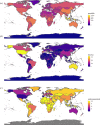What would it take to describe the global diversity of parasites?
- PMID: 33203333
- PMCID: PMC7739500
- DOI: 10.1098/rspb.2020.1841
What would it take to describe the global diversity of parasites?
Abstract
How many parasites are there on Earth? Here, we use helminth parasites to highlight how little is known about parasite diversity, and how insufficient our current approach will be to describe the full scope of life on Earth. Using the largest database of host-parasite associations and one of the world's largest parasite collections, we estimate a global total of roughly 100 000-350 000 species of helminth endoparasites of vertebrates, of which 85-95% are unknown to science. The parasites of amphibians and reptiles remain the most poorly described, but the majority of undescribed species are probably parasites of birds and bony fish. Missing species are disproportionately likely to be smaller parasites of smaller hosts in undersampled countries. At current rates, it would take centuries to comprehensively sample, collect and name vertebrate helminths. While some have suggested that macroecology can work around existing data limitations, we argue that patterns described from a small, biased sample of diversity aren't necessarily reliable, especially as host-parasite networks are increasingly altered by global change. In the spirit of moonshots like the Human Genome Project and the Global Virome Project, we consider the idea of a Global Parasite Project: a global effort to transform parasitology and inventory parasite diversity at an unprecedented pace.
Keywords: biodiversity estimation; museum collections; parasites; systematics; tapeworms.
Conflict of interest statement
We declare we have no competing interests.
Figures




References
-
- Larsen BB, Miller EC, Rhodes MK, Wiens JJ. 2017. Inordinate fondness multiplied and redistributed: the number of species on earth and the new pie of life. Q Rev. Biol. 92, 229–265. (10.1086/693564) - DOI
-
- Rohde K. 1982. Ecology of marine parasites. St Lucia, Australia: University of Queensland Press.
MeSH terms
LinkOut - more resources
Full Text Sources

